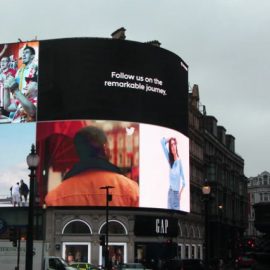

This article is an excerpt from the Shortform book guide to "The Leadership Challenge" by James M. Kouzes and Barry Z. Posner. Shortform has the world's best summaries and analyses of books you should be reading.
Like this article? Sign up for a free trial here .
Does your team share in your vision of your organization’s way forward? What can you do to inspire a common vision in the people you lead?
People are naturally drawn to leaders who inspire a shared vision of a better world because they want to feel like they are a part of something important. In their book The Leadership Challenge, bestselling authors and long-time research partners James Kouzes and Barry Posner outline two guidelines for inspiring a shared vision in your team: 1) envision a positive future, and 2) get others on board.
Here is how you can inspire a shared vision among your subordinates.
Outstanding Leaders Inspire a Shared Vision
When you inspire a shared vision in your team, you ignite their passion, which motivates and excites them. These two guidelines will help you inspire your team:
- Envision a positive version of the future that includes exciting and bold possibilities.
- Get others on board. Help them see the possibilities and opportunities of your vision.
1. Envision a Positive Future
Envisioning a positive future starts by seeing the potential of the future. A specific vision of the future gives you a theme for your career or life: a guiding principle on which you can base your decisions.
Often, visionary leaders have difficulty pinpointing where their visionary thinking comes from, chalking it up to intuition or a gut feeling. While these sources of inspiration are vague and hard to quantify, fortunately, there are specific steps you can take to prompt visionary thinking:
- Examine Your Past. To properly see the future, first reflect on your history:
- If you’ve made mistakes in the past, studying them will prevent you from repeating them.
- If you made wise choices, reflecting on them will help you know what to do in similar situations.
- Mind the Present. Strive to notice things outside of your immediate reach of attention:
- Examine your workplace and community: Notice what people are doing that they weren’t doing five years ago: what they’re using or no longer using, how they’re working, what looks different today in your workplace or community.
- Listen to your team members: Notice their topics of conversation: what they say they need, what’s preventing them from doing their jobs, what they want to see changed.
- Scout the Future. As a leader, your job is to think about the next project and the one after that (and after that).
- Be on the lookout for developments in your workplace, industry, or the wider world around you. Changes in technology, economics, arts, demographics, and politics, as well as changes within your organization, can affect your vision.
- Seek out information about trends and innovations through news feeds, podcasts, documentaries, and the like.
2. Get Others on Board
Once you’ve created a solid, specific, and inspiring vision, inspire your teammates to be equally excited. If you engage team members in your vision, not only will they be more excited, but they’ll also feel more secure in you and your organization, especially during times of change.
- Change can be unnerving, but your team members will have more confidence in your ability to navigate challenges if they feel you have a clear vision.
- It’s analogous to driving through fog versus driving on a clear day: The drive is less scary for your passengers when they can see down the road.
To do this, follow these steps:
- Seek input.
- Be unique.
- Emphasize meaningfulness.
- Illustrate your vision.
- Appeal to emotions.
- Be energetic.
- Be positive.
1. Seek Input
To engage your team in your vision, you need more than your vision: You need to incorporate their visions as well.
- No one wants to merely be told what to do—people are excited and energized when they’re able to contribute to the development of a strategy, as well as its implementation.
- When people feel like they’re participating, they feel ownership of the strategy, which makes them more invested in its outcome.
- When people feel heard, they feel valued.
By fully listening to others, you can learn what drives them, and what you can incorporate into your shared vision.
- Allow your people to voice their thoughts, desires, and concerns so they feel heard.
- Ask probing questions and make it clear that you’re open to ideas other than your own.
- Be prepared to lose arguments in pursuit of the common good.
2. Be Unique
To engage your team in your vision, help them to see how their efforts will make a uniquely positive difference in the world. A compelling vision shows people how they can be different from others, which translates into higher levels of commitment and enthusiasm.
- When people feel they’re following a unique vision, they have a sense of pride.
- They feel more enthusiastic than they would if following an ordinary vision—no one gets excited about doing the same thing as everyone else.
- Emphasizing uniqueness also allows people to feel they can express their own unique vision or purpose within that larger purpose.
3. Emphasize Meaningfulness
People want, more than anything else, to feel a sense of purpose and for their lives to have meaning. This is ultimately more important than making money. Therefore, focus others’ attention on the greater cause behind your vision. People commit more readily and wholeheartedly to causes than to strategies.
Show your team how their actions in your organization matter outside the organization. For example, emphasize how your company or division helps your customers live their best lives, or solves problems for clients that resonate throughout the industry.
4. Illustrate Your Vision
People are visual and respond to image-based words more strongly than to abstract concepts. Images evoke feelings, and image-based words inspire. For example, a study found that when researchers described a line of toys with visual descriptions such as, “will make wide-eyed kids laugh,” participants reacted more strongly than to the more abstract “will be enjoyed by all of our customers.”
Translate your vision into tangible, actionable, visual, and specific terms that your team members can readily recognize and visually imagine. Use image-based concepts to paint a clear picture of what your vision will look, feel, and sound like. By seeing it in their mind’s eye, your team members will be able to generate their own enthusiasm for your vision, which will mirror yours.
For example, when the Australian branch of tool manufacturer Hilti Corporation wanted to excite its workforce, its management came up with a slogan that allowed workers to picture their common purpose: “We’re Painting Australia Red.” This was a simple and effective way to envision every worksite and garage in the country equipped with items in Hilti’s signature color, and it increased employees’ enthusiasm.
Use Symbolic Words
Additionally, to bring your vision to life, use metaphors, symbols, stories, and quotes that allow your team members to hear, see, and recognize what you’re envisioning. Using a metaphor to frame your vision can help others understand it better.
People use metaphors all the time in their everyday language—sports metaphors, war metaphors, machine metaphors, and so on. You can use a common metaphor like these to emphasize your point. For instance, you might compare your organization to a farmer’s market, offering fresh items that change according to the seasons or demand, if that fits with the purpose of your organization, even if your organization has nothing to do with food.
Avoid Loaded Words
Be aware also of the connotations of your words, in addition to their official definitions. Certain words evoke images that can associate your organization or concept with specific things, whether or not you mean to.
For example, in one study, researchers had two groups of people play a game. Both played the same game using the same rules, but one group was told the name of the game was “The Community Game,” while the other group was told the name was “The Wall Street Game.” The results were striking: Of those playing the Community Game, 70% played cooperatively. Of those playing the Wall Street Game, only 30% played cooperatively, and even then, only at first—once they saw others weren’t playing cooperatively, they stopped cooperating as well. This illustrates the power specific words can have over people’s interpretations of their world.
4. Appeal to Emotions
If you can get other people to feel emotions about your vision, you’ll have much greater success bringing them on board. Emotions inspire excitement and also help with memory. If people connect emotionally with your vision, they’ll remember it in more detail for a longer period of time.
You can create an emotional connection in several ways:
- Use stories, as we discussed above. Additionally, use examples to illustrate your stories. Concrete examples have been shown to elicit stronger emotions than general statements. For example, showing people a picture of a starving child from a poor country will prompt many more people to donate to charity than will the statement “food shortages are affecting more than three million children.”
- Use physical props to demonstrate your message. Physically involving people in your message will connect with their emotions much more directly. In one example, trainers who were helping volunteers understand how hospice patients and their families deal with loss asked the volunteers to write down on index cards things that meant a lot to them and that they’d be upset to lose—anything from family members to pets to experiences like taking a hike. The trainers then randomly took cards from some of the volunteers, symbolizing a loss of those things. The effect was striking: Some volunteers even started crying, and they understood on a deeper level what their patients were experiencing.
5. Be Energetic
People won’t follow a leader who’s only mildly enthusiastic about their vision. Leaders need to radiate vast amounts of energy in order to inspire energy in their team.
You can portray energy through the way you talk and move. People who are perceived as charismatic behave more animatedly than others. They:
- Smile more.
- Speak faster.
- Pronounce words clearly.
- Move their heads and hands more.
6. Be Positive
You’ll be more likely to engage others with a positive attitude. As a leader, you’ll need to bring your constituents through difficult times with optimism—to inspire hope when your team faces obstacles or setbacks. A large part of this will come from making it clear you believe in the abilities of others, so that difficulties can make them feel empowered rather than discouraged.
All projects and organizations will face challenges, and if you help your people approach these challenges with a confident attitude, they’ll meet them better. If you instead, have a negative attitude or convey anger, disappointment, or exasperation when your team has difficulties, people will be less willing to seek you out in times of trouble. The resulting disconnect between you and your team can allow problems to worsen before they start to be addressed.

———End of Preview———
Like what you just read? Read the rest of the world's best book summary and analysis of James M. Kouzes and Barry Z. Posner's "The Leadership Challenge" at Shortform .
Here's what you'll find in our full The Leadership Challenge summary :
- A field guide for becoming the kind of leader that other people want to follow
- The five principles of leadership and their associated guidelines
- Why before you can lead others, you must have a clear understanding of yourself






